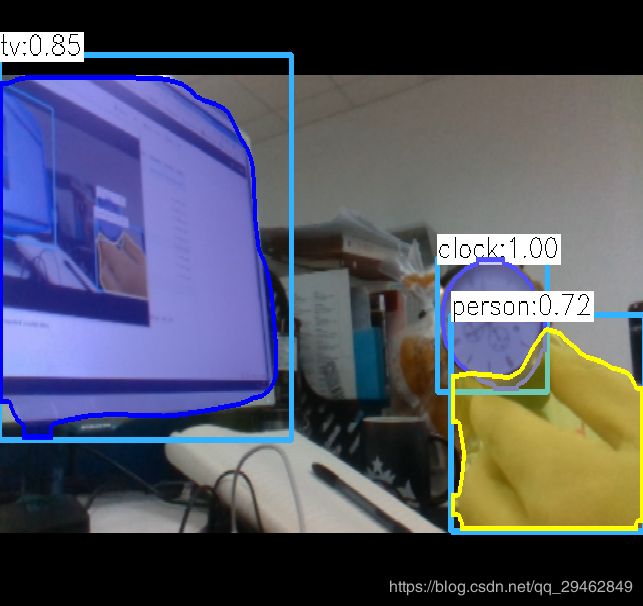C++调用mask rcnn进行实时检测--opencv4.0
介绍
Opencv在前面的几个版本中已经支持caffe、tensorflow、pytorch训练的几种模型,包括分类和物体检测模型(SSD、Yolo),针对tensorflow,opencv与tensorflow object detection api对接,可以通过该api训练模型,然后通过opencv调用,这样就可以把python下的环境移植到C++中。
关于tensorflow object detection api,后面博文会详细介绍
数据准备与环境配置
基于mask_rcnn_inception_v2_coco_2018_01_28的frozen_inference_graph.pb,这个模型在tensorflow object detection api中可以找到,然后需要对应的mask_rcnn_inception_v2_coco_2018_01_28.pbtxt,以及colors.txt,mscoco_labels.names。
opencv必须是刚发布的4.0版本,该版本支持mask rcnn和faster rcnn,低版本不支持哦,注意opencv4.0中在配置环境时,include下少了一个opencv文件夹,只有opencv2,这是正常的。
好了,废话不多说了,直接上源代码,该代码调用usb摄像头进行实时检测,基于单幅图像的检测修改下代码即可。
#include
#include
#include
#include
#include
#include
#include
using namespace cv;
using namespace dnn;
using namespace std;
// Initialize the parameters
float confThreshold = 0.5; // Confidence threshold
float maskThreshold = 0.3; // Mask threshold
vector classes;
vector colors;
// Draw the predicted bounding box
void drawBox(Mat& frame, int classId, float conf, Rect box, Mat& objectMask);
// Postprocess the neural network's output for each frame
void postprocess(Mat& frame, const vector& outs);
int main()
{
// Load names of classes
string classesFile = "./mask_rcnn_inception_v2_coco_2018_01_28/mscoco_labels.names";
ifstream ifs(classesFile.c_str());
string line;
while (getline(ifs, line)) classes.push_back(line);
// Load the colors
string colorsFile = "./mask_rcnn_inception_v2_coco_2018_01_28/colors.txt";
ifstream colorFptr(colorsFile.c_str());
while (getline(colorFptr, line))
{
char* pEnd;
double r, g, b;
r = strtod(line.c_str(), &pEnd);
g = strtod(pEnd, NULL);
b = strtod(pEnd, NULL);
Scalar color = Scalar(r, g, b, 255.0);
colors.push_back(Scalar(r, g, b, 255.0));
}
// Give the configuration and weight files for the model
String textGraph = "./mask_rcnn_inception_v2_coco_2018_01_28/mask_rcnn_inception_v2_coco_2018_01_28.pbtxt";
String modelWeights = "./mask_rcnn_inception_v2_coco_2018_01_28/frozen_inference_graph.pb";
// Load the network
Net net = readNetFromTensorflow(modelWeights, textGraph);
net.setPreferableBackend(DNN_BACKEND_OPENCV);
net.setPreferableTarget(DNN_TARGET_CPU);
// Open a video file or an image file or a camera stream.
string str, outputFile;
VideoCapture cap(0);//根据摄像头端口id不同,修改下即可
//VideoWriter video;
Mat frame, blob;
// Create a window
static const string kWinName = "Deep learning object detection in OpenCV";
namedWindow(kWinName, WINDOW_NORMAL);
// Process frames.
while (waitKey(1) < 0)
{
// get frame from the video
cap >> frame;
// Stop the program if reached end of video
if (frame.empty())
{
cout << "Done processing !!!" << endl;
cout << "Output file is stored as " << outputFile << endl;
waitKey(3000);
break;
}
// Create a 4D blob from a frame.
blobFromImage(frame, blob, 1.0, Size(frame.cols, frame.rows), Scalar(), true, false);
//blobFromImage(frame, blob);
//Sets the input to the network
net.setInput(blob);
// Runs the forward pass to get output from the output layers
std::vector outNames(2);
outNames[0] = "detection_out_final";
outNames[1] = "detection_masks";
vector outs;
net.forward(outs, outNames);
// Extract the bounding box and mask for each of the detected objects
postprocess(frame, outs);
// Put efficiency information. The function getPerfProfile returns the overall time for inference(t) and the timings for each of the layers(in layersTimes)
vector layersTimes;
double freq = getTickFrequency() / 1000;
double t = net.getPerfProfile(layersTimes) / freq;
string label = format("Mask-RCNN on 2.5 GHz Intel Core i7 CPU, Inference time for a frame : %0.0f ms", t);
putText(frame, label, Point(0, 15), FONT_HERSHEY_SIMPLEX, 0.5, Scalar(0, 0, 0));
// Write the frame with the detection boxes
Mat detectedFrame;
frame.convertTo(detectedFrame, CV_8U);
imshow(kWinName, frame);
}
cap.release();
return 0;
}
// For each frame, extract the bounding box and mask for each detected object
void postprocess(Mat& frame, const vector& outs)
{
Mat outDetections = outs[0];
Mat outMasks = outs[1];
// Output size of masks is NxCxHxW where
// N - number of detected boxes
// C - number of classes (excluding background)
// HxW - segmentation shape
const int numDetections = outDetections.size[2];
const int numClasses = outMasks.size[1];
outDetections = outDetections.reshape(1, outDetections.total() / 7);
for (int i = 0; i < numDetections; ++i)
{
float score = outDetections.at(i, 2);
if (score > confThreshold)
{
// Extract the bounding box
int classId = static_cast(outDetections.at(i, 1));
int left = static_cast(frame.cols * outDetections.at(i, 3));
int top = static_cast(frame.rows * outDetections.at(i, 4));
int right = static_cast(frame.cols * outDetections.at(i, 5));
int bottom = static_cast(frame.rows * outDetections.at(i, 6));
left = max(0, min(left, frame.cols - 1));
top = max(0, min(top, frame.rows - 1));
right = max(0, min(right, frame.cols - 1));
bottom = max(0, min(bottom, frame.rows - 1));
Rect box = Rect(left, top, right - left + 1, bottom - top + 1);
// Extract the mask for the object
Mat objectMask(outMasks.size[2], outMasks.size[3], CV_32F, outMasks.ptr(i, classId));
// Draw bounding box, colorize and show the mask on the image
drawBox(frame, classId, score, box, objectMask);
}
}
}
// Draw the predicted bounding box, colorize and show the mask on the image
void drawBox(Mat& frame, int classId, float conf, Rect box, Mat& objectMask)
{
//Draw a rectangle displaying the bounding box
rectangle(frame, Point(box.x, box.y), Point(box.x + box.width, box.y + box.height), Scalar(255, 178, 50), 3);
//Get the label for the class name and its confidence
string label = format("%.2f", conf);
if (!classes.empty())
{
CV_Assert(classId < (int)classes.size());
label = classes[classId] + ":" + label;
}
//Display the label at the top of the bounding box
int baseLine;
Size labelSize = getTextSize(label, FONT_HERSHEY_SIMPLEX, 0.5, 1, &baseLine);
box.y = max(box.y, labelSize.height);
rectangle(frame, Point(box.x, box.y - round(1.5*labelSize.height)), Point(box.x + round(1.5*labelSize.width), box.y + baseLine), Scalar(255, 255, 255), FILLED);
putText(frame, label, Point(box.x, box.y), FONT_HERSHEY_SIMPLEX, 0.75, Scalar(0, 0, 0), 1);
Scalar color = colors[classId%colors.size()];
// Resize the mask, threshold, color and apply it on the image
resize(objectMask, objectMask, Size(box.width, box.height));
Mat mask = (objectMask > maskThreshold);
Mat coloredRoi = (0.3 * color + 0.7 * frame(box));
coloredRoi.convertTo(coloredRoi, CV_8UC3);
// Draw the contours on the image
vector contours;
Mat hierarchy;
mask.convertTo(mask, CV_8U);
findContours(mask, contours, hierarchy, RETR_CCOMP, CHAIN_APPROX_SIMPLE);
drawContours(coloredRoi, contours, -1, color, 5, LINE_8, hierarchy, 100);
coloredRoi.copyTo(frame(box), mask);
}
实验结果
不过检测速度很慢,I7-8700k,GTX1060下需要1s每帧,达不到实时性要求。。。
实验数据
本博文所有的数据可以从这里下载:opencv调用mask rcnn数据


